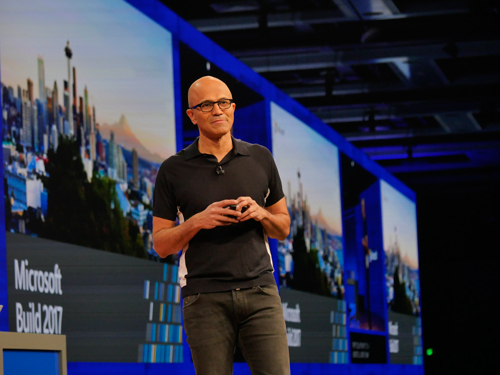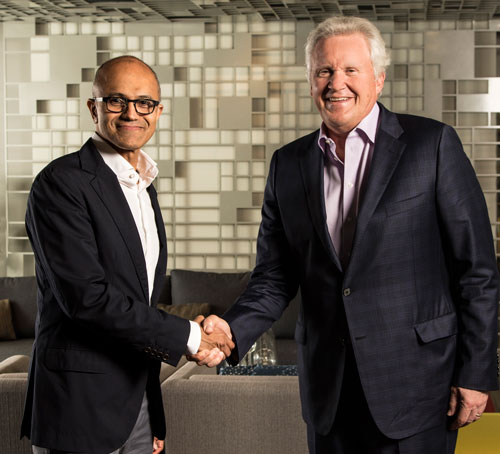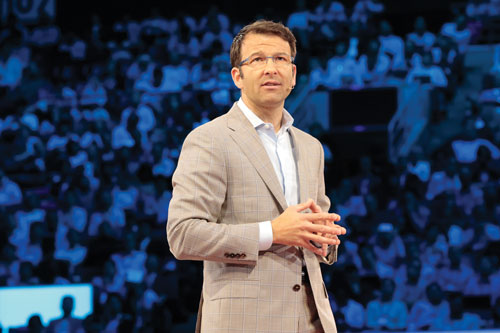In-Depth
What To Expect from Microsoft's WPC, Ahem, Inspire 2017
Controversy swirls around the new name Microsoft slapped on the event formerly known as the Worldwide Partner Conference (WPC). The structure, focus and audience, however, should feel familiar to any attendee of previous WPCs.
- By Scott Bekker
- July 06, 2017
The biggest mystery around Microsoft's annual, global partner gathering this year swirls around the conference's new name.
For 14 summers, since 2003, the event has been known as the Microsoft Worldwide Partner Conference (WPC). Held in a series of major U.S. cities, and three times in Toronto, Canada, the WPC lately has drawn more than 10,000 partners -- roughly half of them from the United States and half from the rest of the world.
Starting this year, with the show that runs July 9-13 in Washington, D.C., the conference will be called Microsoft Inspire.
Confusion among partners is widespread and stems from multiple sources. For one thing, partners were used to calling it the Worldwide Partner Conference or WPC, and in the run-up to the 2017 event, still often use that name. Conversations at International Association of Microsoft Channel Partners (IAMCP) chapter meetings or among partners or vendors making plans in advance of the show typically involve someone saying a variation on "WPC, I mean, Inspire."
Beyond the power of habit, the WPC was also nothing if not a straightforward and descriptive name that told people exactly what they were getting into and what to expect. The announcement of the name change in December 2016, five months after Microsoft's marketing for "WPC 2017" had begun, also didn't help.
 Microsoft CEO Satya Nadella on stage at Build this spring. With a more abstract conference name, could Inspire become a bigger platform for major Microsoft product and technology announcements?
Microsoft CEO Satya Nadella on stage at Build this spring. With a more abstract conference name, could Inspire become a bigger platform for major Microsoft product and technology announcements?
Additionally, there's the fact that Microsoft's public explanations don't precisely line up. There's the one given by Chris Capossela, executive vice president and chief marketing officer, in a blog post in December: "This new name reflects how Microsoft and our partner community inspire each other to innovate and deliver powerful new solutions to customers."
That was the theme Gavriella Schuster expanded on in her own blog post about the change that day. "This will continue to be the great conference our partners have grown to love, but with a new name that reflects how Microsoft and our partner community inspire each other to innovate and deliver powerful new solutions to customers," said Schuster, corporate vice president of the Microsoft Worldwide Partner Group (WPG). "The name Microsoft Inspire better represents what this event provides. It is a destination event that fosters partner-to-partner connections, drives engagement with Microsoft, and surfaces new ideas to help bring our partners' goals and visions to life and accelerate business while we work as one to deliver the very best solutions to our customers."
The other, slightly different explanation has less to do with how inspiring partners and Microsoft employees may be to each other. "The change was made to further align the conference with our other flagship Microsoft events, including Microsoft Ignite, Microsoft Envision and Microsoft Inspire. It will continue to be the great event our partners have grown to love, but with a brand-new name," Microsoft states in a Microsoft Inspire Q&A on the question of why the name of the event changed (the top question in the Q&A).
That second explanation also aligns with the fact that the announcement coming from Capossela, whose responsibilities are broader than the partner organization, dealt with a raft of announcements about Microsoft's 2017 conference schedule.
As with most happenings throughout history, it's entirely probable that the Inspire naming is overdetermined, with both reasons being true. Microsoft wants the naming of the WPC to fit with Ignite and Envision, and Inspire makes sense to Microsoft as a new name because of the partner-to-partner, partner-to-Microsoft and Microsoft-to-partner energy that gets generated each July.
Seeping into the cracks left between Microsoft's broad messages, some dark rumors are circulating among partners and vendors. That this is a sign that partners are being de-emphasized at Microsoft. That Inspire is being groomed to become a conference in the future where customers and partners both attend, much like the old Microsoft Convergence conference that focused on Microsoft Business Solutions and Dynamics. That other events like Microsoft's internal sales kickoff might be combined with Inspire, given both events' scheduling at the start of Microsoft's fiscal year.
 Microsoft CEO Satya Nadella with now outgoing GE CEO Jeffrey Immelt from WPC 2016. Does the Inspire name signal more focus on customers than traditional partners?
Microsoft CEO Satya Nadella with now outgoing GE CEO Jeffrey Immelt from WPC 2016. Does the Inspire name signal more focus on customers than traditional partners?
It's possible that some of those things may come to pass, but there is very little in the agenda for Inspire 2017 that suggests that any of those things are so. In fact, the schedule for the conference is nearly indistinguishable from any previous WPC, aside from the evolving mix of concepts and products that are featured each year as technology marches constantly forward.
For one thing, Inspire will be held in a location familiar to former WPC attendees. Based at the Walter E. Washington Convention Center in Washington, D.C., it will be the third time for the partner conference at that site. Microsoft previously held WPCs in Washington, D.C., in 2010 and 2014.
The mix of the show will be similar, as well, with major executive keynotes in the mornings at the nearby Verizon Center, a huge venue that's home to the Washington Wizards, Capitals, Mystics and the Georgetown Hoyas. The rest of the daytime conference action happens a few blocks away at the Washington Convention Center. The most significant sessions are the General Sessions, which are large ballroom talks given by the Verizon Center speakers or their on-stage guests, as well as other senior Microsoft executives. Another large-scale type of session is the Regional General Sessions, which involve Microsoft executives from a specific geography explaining how the themes and programs laid out elsewhere during the show will land in that country. Breakout Sessions cover technologies and business practices, and may be delivered by Microsoft employees, partners, business consultants, authors, professional speakers or vendors. Similarly, Panels pull together industry experts for moderated discussions. This year, Microsoft is also emphasizing hands-on workshops and so-called Power Sessions, which are highly focused 20-minute sessions similar in concept to a TED Talk.
The Commons area, which is normally near the exhibit booths from Microsoft and its vendor partners, features various themed lounges where partners who share geographies, technical interests or other affiliations can mingle. Two areas of emphasis in The Commons this year will be Immersive Sessions for hands-on deep dives with particular technologies and a Commons Theater for more 20-minute presentations from Microsoft, partners and other subject-matter experts.
As with WPCs past, nights will be filled with partner-to-partner dinner meetings, cocktail hours, large Microsoft parties and parties by conference sponsors and other technology companies, consulting companies and organizations, such as the IAMCP.
The big parties this year will match those of other years, with Wednesday night featuring the annual Partner Celebration at Nationals Park with entertainment by Carrie Underwood. Many of Microsoft's geographic subsidiaries sponsor big parties, as well. The U.S. subsidiary party for partners will be Tuesday night at the new Smithsonian National Museum of African American History and Culture.
As Microsoft's channel chief and traditional master of ceremonies for the show, Schuster in late May unveiled a slate of keynote speakers that's very similar to recent WPCs.
Carrying on a tradition since Steve Ballmer's time, CEO Satya Nadella will delivery a major keynote that usually involves some news on the product side (more on that in a bit). As the WPG leader, Schuster also has a keynote, which is usually filled with partner program and incentive news.
Reprising his spy-thriller-style keynotes overviewing Microsoft's role in major geopolitical questions, such as legal challenges to mass surveillance, will be President and Chief Legal Officer Brad Smith. Also speaking are Toni Townes-Whitley, corporate vice president of Public Sector and Industry, and Kirk Koenigsbauer, corporate vice president of Office Marketing.
One of the highest-profile keynotes of the WPC era was former COO Kevin Turner's wrap-up keynote, which was equal parts beating on the competition and firing up the partner base. Turner left Microsoft last summer, and his place was taken by Executive Vice President of the Microsoft Worldwide Commercial Business Judson Althoff. While his conference-ending keynote last year was more subdued than a Turner speech, Althoff's sincere and polished delivery carries weight due to his very senior position atop the Worldwide Commercial Business, where he oversees almost all aspects of Microsoft's channel operations. Althoff is on the keynote speaker list again for 2017.
Inspire will be the first high-profile opportunity for partners to get a sense of Ron Huddleston, who as the head of the newly created One Commercial Partner organization plays an important role in how Microsoft allocates its resources for the channel. Huddleston was elevated to corporate vice president of the One Commercial Partner organization on Feb. 1. He reports to Althoff and counts Schuster, as well as the head of the Enterprise Partner Team, Victor Morales, and Kim Akers, who runs an ISV team, among his direct reports. Last year, he had just joined Microsoft ahead of the WPC from Salesforce.com Inc., where he was senior vice president of Global ISV & Channels and played a major role in creating the AppExchange marketplace.
It's possible Huddleston's keynote could cover some of the kinds of material previously addressed at the WPC by Microsoft Chief Evangelist Steve "Guggs" Guggenheimer. In a blog post from the Microsoft Build show in May, Guggs disclosed that he was leaving the developer evangelism group (DX) after 4.5 years to take a role in Microsoft's artificial intelligence (AI) and research efforts. "As Microsoft accelerates its AI investments to amplify human ingenuity, I look forward to seeing what Charlotte Yarkoni, CVP, John Shewchuk, Technical Fellow, and Ron Huddleston, CVP, do for developers and ISVs as they onboard the teams that previously comprised DX," he said.
 Judson Althoff (pictured) and his direct report, Ron Huddleston, both have keynote roles at Inspire, and both are key players when it comes to allocating Microsoft's considerable channel resources.
Judson Althoff (pictured) and his direct report, Ron Huddleston, both have keynote roles at Inspire, and both are key players when it comes to allocating Microsoft's considerable channel resources.
In a few public blog posts on the Microsoft site late last year and this year, Huddleston has encouraged partners of all types to concentrate on developing intellectual property -- a major recurring theme from Microsoft to its partners dating back to Phil Sorgen's time atop the WPG. Whether Huddleston talks about development opportunities with Microsoft products generally, resources for ISVs, opportunities for development by systems integration partners, or potential new ways Microsoft will go about distributing partner-related resources, Inspire attendees in the room in Washington, D.C., and remotely over the Web will be listening closely.
One other major thing could change about the keynotes with the shift from WPC to Inspire, either this year or later. While the big keynotes are well attended, with thousands of partners filling professional sports arenas, this less partner-specific name could lead to bigger news bombshells from Microsoft during the keynotes, especially Nadella's. Some years, Microsoft executives have been skittish about breaking major news at the WPC, given that it was so specifically tied to the channel. By both wanting to keep the content relevant to partners, and perhaps not wanting to make major announcements at a conference the industry at large might not view as a top-tier tech technology event, such as, say, Microsoft Build, Microsoft has shied away from revealing really groundbreaking technology developments at the WPC.
Now, with a conference name that's nearly indistinguishable among Microsoft's other abstract conference titles, this partner event could become part of the flywheel of Microsoft technology announcements. Inspire has the added benefit of coming right at the beginning of the Microsoft fiscal year, making it a better candidate for big news announcements than many other Microsoft events.
Despite all that could change at Inspire, Ryan Risley expects that the most important elements of this year's show will be identical to what they were at the WPC. Risley, partner and CTO of the Technology Consulting Practice at Wipfli LLP, is a WPC veteran from the Washington, D.C., area, and a longtime IAMCP officeholder. Most of the keynotes and sessions are recorded and available for viewing later, he notes. The key is packing in the irreplaceable face-to-face meetings with partners and Microsoft counterparts wherever and whenever you can get them.
Asked to provide a rough allocation of his time at the WPC, Risley says he shoots for 40 percent one-on-one daytime meetings, 40 percent after-hours meetings at parties and events, 10 percent hanging around The Commons lounges, and 10 percent in sessions.
"Meet people in the daytime, and get to know them at night," Risley says. "Plan your schedule way ahead, and then go with the flow, especially after hours. If you get a VIP invitation, take it."
Can't make it to Washington, D.C., for Inspire? Catch RCP's complete conference coverage here.